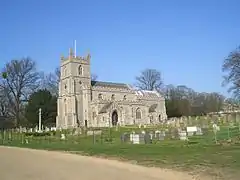East Raynham
East Raynham is a village and former civil parish, now in the parish of Raynham, in the North Norfolk district, in the county of Norfolk, England. It is located on the A1065 some 4 miles (6.4 km) south-west of Fakenham. The River Wensum flows close to the village. The village can trace its origins back and before the Domesday survey of 1086 when it was known as Reinham.[1] Raynham, Massachusetts took the village's name at its incorporation in 1731 at the time of Charles Townshend, 2nd Viscount Townshend (1674–1738), Leader of the House of Lords. In 1931 the parish had a population of 130.[2]
| East Raynham | |
|---|---|
 The Church of St. Mary | |
 East Raynham Location within Norfolk | |
| OS grid reference | TF8725 |
| • London | 110 miles |
| Civil parish | |
| District | |
| Shire county | |
| Region | |
| Country | England |
| Sovereign state | United Kingdom |
| Post town | Fakenham |
| Postcode district | NR21 |
| Dialling code | 01328 |
| Police | Norfolk |
| Fire | Norfolk |
| Ambulance | East of England |
| UK Parliament | |
History
East Raynham's name is of Anglo-Saxon origin and derives from the Old English for the eastern portion of 'Regna's' homestead or village.[3]
In the Domesday Book, East and West Raynham are listed together as a settlement of 33 households in the hundred of Brothercross. In 1086, the village formed part of the East Anglian estates of King William I, Roger Bigod and Reginald, son of Ivo. [4]
The town of Raynham, Massachusetts is named after East Raynham at the time when Charles Townshend was Lord of Raynham Hall.
On 1 April 1935 the parish was abolished to form Raynham.[5]
Geography
East Raynham falls within the constituency of North Norfolk and is represented at Parliament by Duncan Baker MP of the Conservative Party. For the purposes of local government, the parish falls within the district of North Norfolk.
Raynham Hall
Raynham Hall is a Seventeenth Century manor house first built by Sir Roger Townshend. The hall still stands today, reputedly haunted by the Brown Lady and was the residence of Charles Townshend, an Eighteenth Century Secretary of State.
The Church of St. Mary
East Raynham's parish church is dedicated to Saint Mary and is situated in the parkland of Raynham Hall. The church was largely rebuilt in the mid-Nineteenth Century on the site of an older Medieval building by Clark and Holland of Newmarket. St. Mary's also holds a stone memorial to Maj-Gen. Charles Townshend, who was a distant relative of the Townshends of Raynham Hall, and the grave of Charles Townshend, 2nd Viscount.[6] In 2002, the ring of bells were restored[7] and, in July 2002, received a private visit from Queen Elizabeth II.[8]
Recreation
Much of the area can be visited by a circular walk, which takes in mixed woodland, water meadows, arable land and historic buildings, almost entirely on the Raynham estate.[9]
War Memorial
East Raynham's war memorial takes the form stone column topped with a crucifix. The memorial lists the following names for the First World War:
- Sergeant William H. Green (1884-1914), 1st Battalion, Royal Norfolk Regiment
- Sergeant Herbert W. L. Leonard (1889-1917), 1/5th Battalion, Royal Norfolk Regiment
- Lance-Sergeant Henry Green (1856-1918), Royal Defence Corps
- Lance-Sergeant George W. Carr (1890-1917), 8th Battalion, Royal Norfolk Regiment
- Gunner James Graver (1889-1917), 86th (Heavy) Battery, Royal Garrison Artillery
- Private Augustus Neave (1889-1918), 7th Battalion, Royal East Kent Regiment
- Private Benjamin W. Boggis (1890-1917), 13th Battalion, Durham Light Infantry
- Private Richard Plane (1894-1917), 2nd Battalion, Royal Norfolk Regiment
- Private Albert L. Fox (1896-1915), 1/5th Battalion, Royal Norfolk Regiment
- Private Arthur J. Boggis (1883-1917), 8th Battalion, Royal Norfolk Regiment
- Private Bertie T. Vertigan (1890-1917), 15th Battalion, Sherwood Foresters
- Private Cecil E. West (1884-1917), 1/8th Battalion, Royal Warwickshire Regiment
- J. Neave
And, the following for the Second World War:
- Lieutenant Maurice G. R. Kingsford (1923-1944), 5th Battalion, Grenadier Guards
- Lieutenant Nicholas J. R. J. T. Durham (1905-1943), 6th Battalion, Grenadier Guards
- Warrant-Officer Edgar A. Brown (1922-1945), No. 55 Squadron RAF
- Corporal Dorothy S. Roffe (1916-1943), Women's Auxiliary Air Force
- Aircraftman-Second-Class John Graver (1923-1942), Royal Air Force
- Private Basil W. Brown (1918-1941), Sherwood Foresters att. IX Corps Headquarters[10]
Gallery
 Raynham Hall
Raynham Hall.jpg.webp) Interior of St. Mary's Church
Interior of St. Mary's Church.jpg.webp) St. Mary's Church
St. Mary's Church
References
- The Raynhams Archived 2008-07-23 at the Wayback Machine Retrieved February 06 2008
- "Population statistics East Raynham AP/CP through time". A Vision of Britain through Time. Retrieved 2 October 2022.
- University of Nottingham. (2022). Retrieved December 27, 2022. http://kepn.nottingham.ac.uk/map/place/Norfolk/Raynham%20East%20South%20and%20West
- Domesday Book. (1086). Retrieved December 27, 2022. https://opendomesday.org/place/XX0000/east-and-west-raynham/
- "Relationships and changes East Raynham AP/CP through time". A Vision of Britain through Time. Retrieved 2 October 2022.
- Knott, S. (2021). Retrieved December 27, 2022. http://www.norfolkchurches.co.uk/eastraynham/eastraynham.htm
- Cattermole, P. (2002). Retrieved December 27, 2022. https://www.townshend.org/serv-hist-bell.htm
- Townshend. (2002). Retrieved December 27, 2022. https://www.townshend.org/hmvisit.htm
- Circular walk Retrieved February 08 2008
- Pye, A. (2017). Retrieved December 27, 2022. https://media.geograph.org.uk/files/fe9fc289c3ff0af142b6d3bead98a923/East_Raynham_War_Memorial.pdf